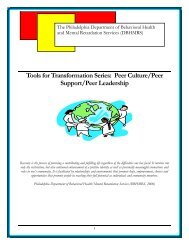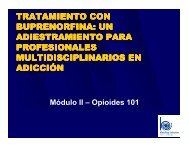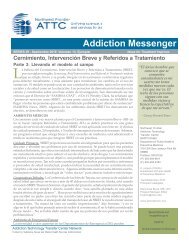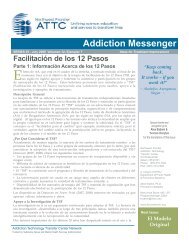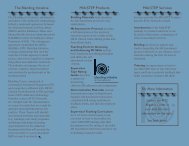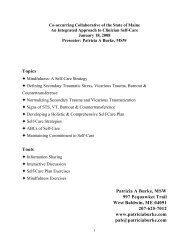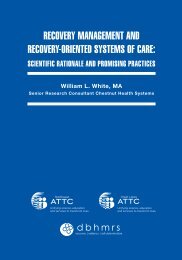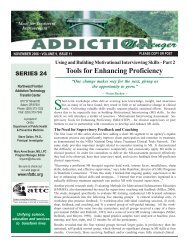alcohol and other drug problems among addiction professionals
alcohol and other drug problems among addiction professionals
alcohol and other drug problems among addiction professionals
Create successful ePaper yourself
Turn your PDF publications into a flip-book with our unique Google optimized e-Paper software.
10. Training <strong>and</strong> Mentoring: Organizations should provide training programs forstaff, administration, managers, supervisors, <strong>and</strong> line staff, with a strong focusupon orienting new employees so they can rapidly become effective in theirjobs. These processes should become st<strong>and</strong>ardized on the agency level consistentwith federal, state, <strong>and</strong> local laws <strong>and</strong> agency policies. Organizationsshould provide on-the-job training <strong>and</strong> mentoring programs to help peopleacquire the competencies necessary to do their jobs. Training is an ongoingessential because of the rapid change in environment <strong>and</strong> the need to addressboth “uncomplicated” <strong>addiction</strong> <strong>and</strong> <strong>addiction</strong> complicated by coexisting mentalhealth disorders, legal <strong>problems</strong>, <strong>and</strong> social <strong>problems</strong>.◆St<strong>and</strong>ardized Training Modules: This participant opted to developst<strong>and</strong>ardized training modules that will clearly define goals <strong>and</strong> objectives.These modules will focus on employee competence <strong>and</strong> improvement ofperformance levels. Elements will include clear definition of training goals<strong>and</strong> desired outcomes, <strong>and</strong> effective measuring of training outcomes usingpre- <strong>and</strong> post-testing <strong>and</strong> evaluations. The participant will then teach aclass following these modules.11. Wellness: Organizations should develop wellness programs <strong>and</strong> practices totake care of employees, <strong>and</strong> provide effective supervision policies <strong>and</strong> practicesthat consider the wellness of the employees. These should include specificscheduled activities, including such things as retreats for the purpose of rejuvenation<strong>and</strong> burn-out prevention, peer support <strong>and</strong> mentoring practices, <strong>and</strong>“growth groups” to enhance professional development. These groups would beaimed at self-awareness <strong>and</strong> “spirituality recharge.”◆◆Core Need Training <strong>and</strong> Wellness White Paper <strong>and</strong> Program:This participant’s project will be a white paper on core need training <strong>and</strong>wellness. Its goal will be to exp<strong>and</strong> a module that the participant has developed,with an exploration of new venues for expansion of this model.It will document key elements of success in mentoring programs to-date.The participant will also begin at least one new program based on thiswhite paper.Self-Assessment Profile: This profile will be designed to help employeesunderst<strong>and</strong> themselves, their assets, <strong>and</strong> their self-care needs,to encourage <strong>and</strong> facilitate greater wellness <strong>and</strong> more effective self-care.It will include a focus on knowledge of their own <strong>and</strong> <strong>other</strong>s’ self-managementstyles, enhancement of personal <strong>and</strong> professional interpersonalskills, <strong>and</strong> improved connections <strong>among</strong> people. This project will also exploreareas <strong>and</strong> methods of change, <strong>and</strong> encourage employees to practicenew methods of improving their skills. It will provide suggestions for elimi-n 52 n





